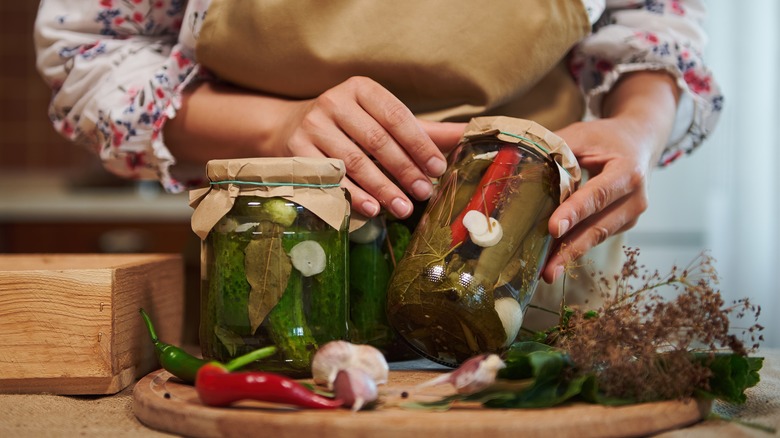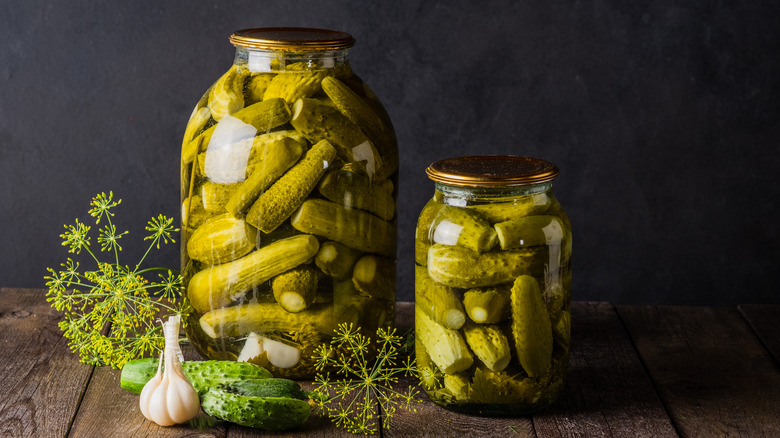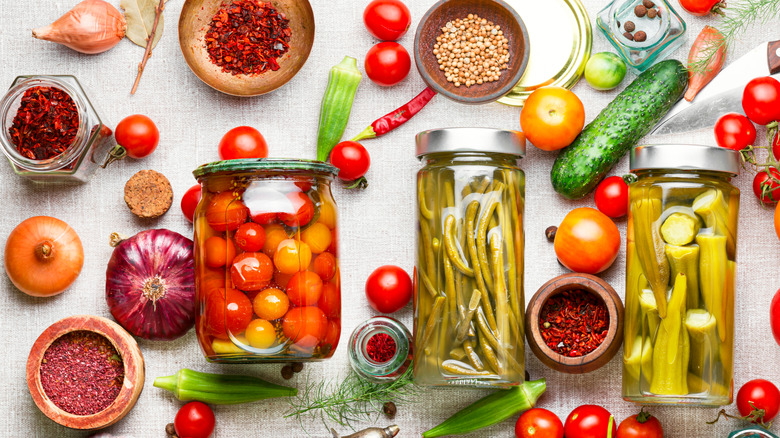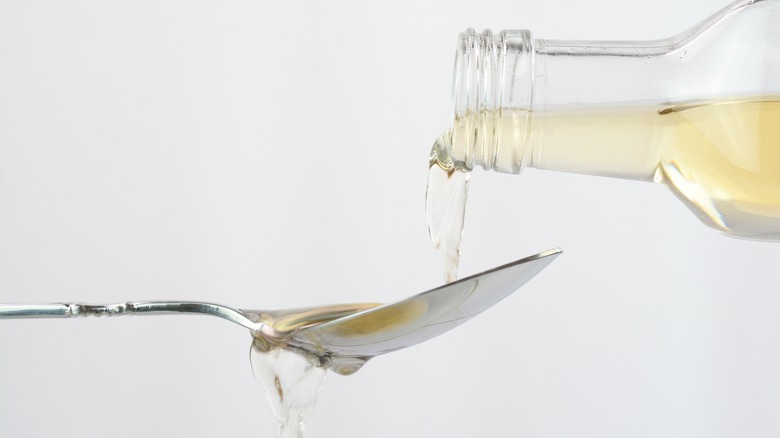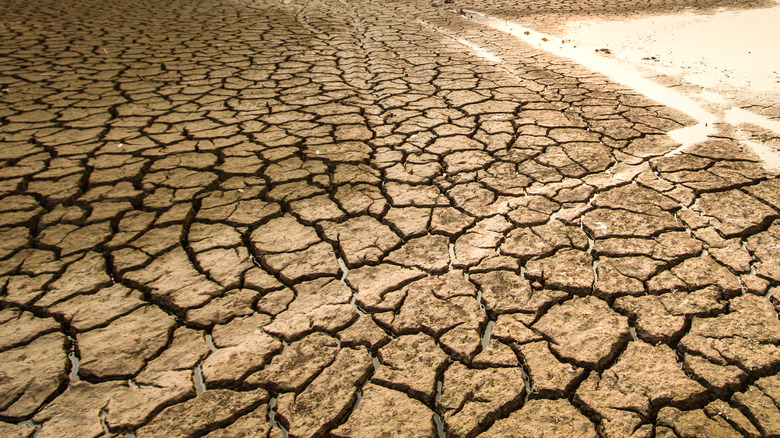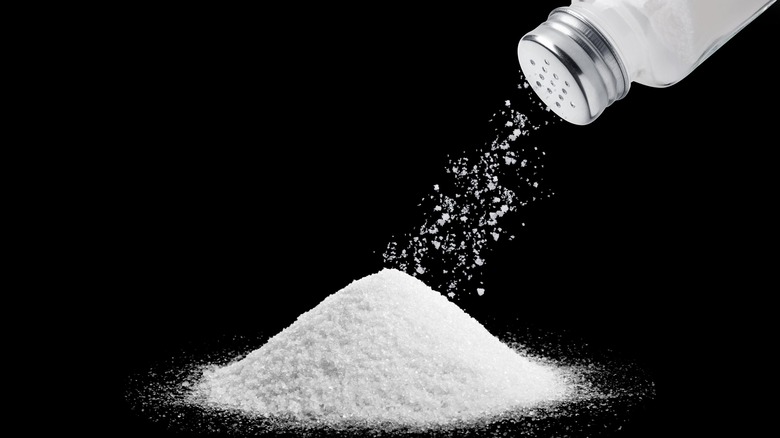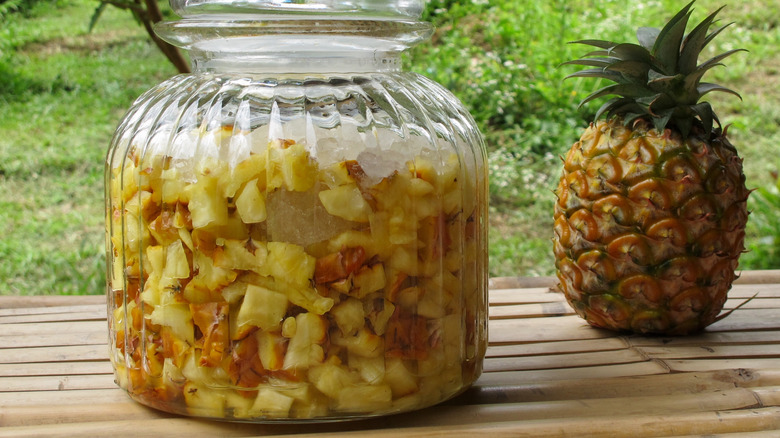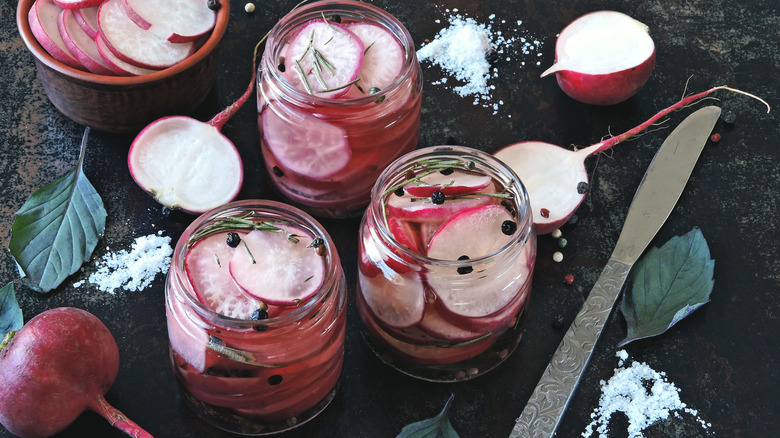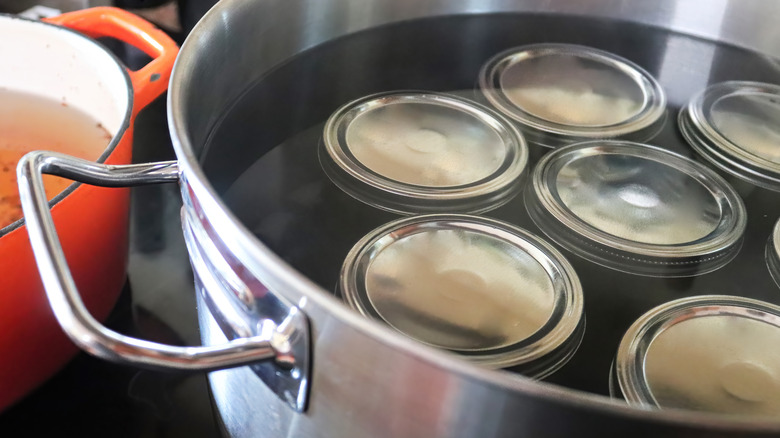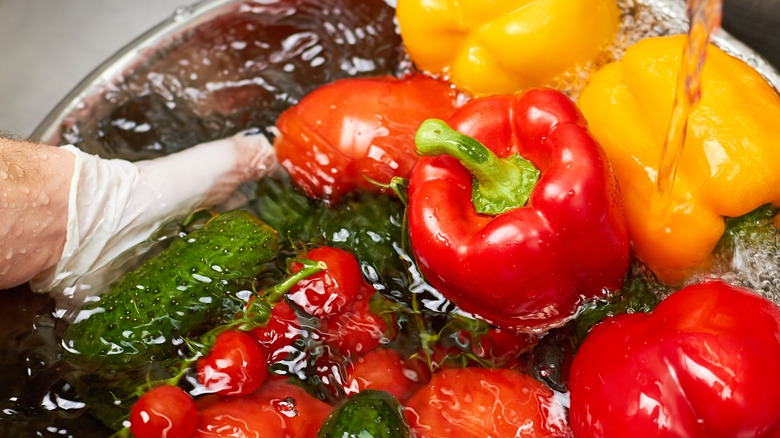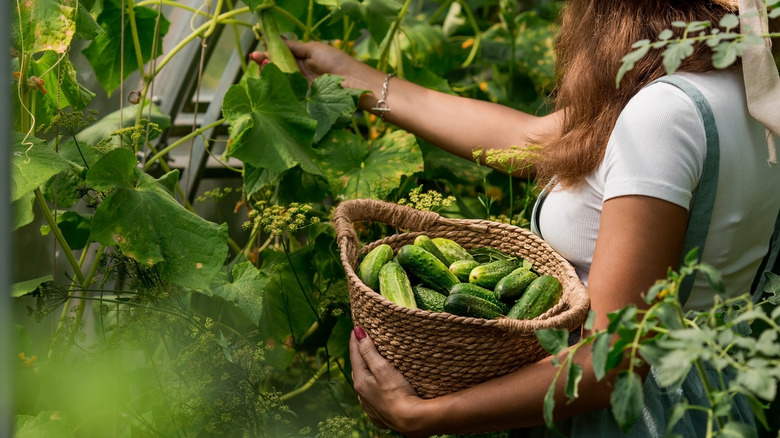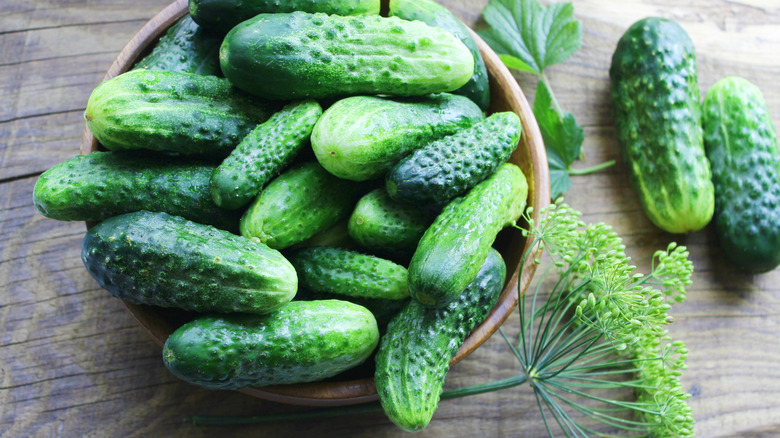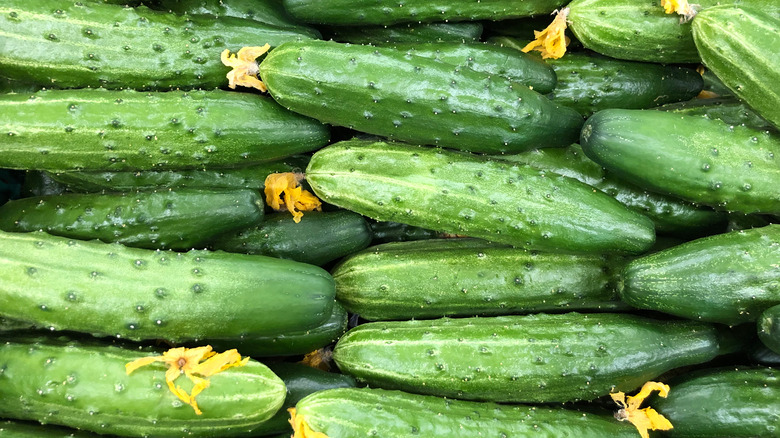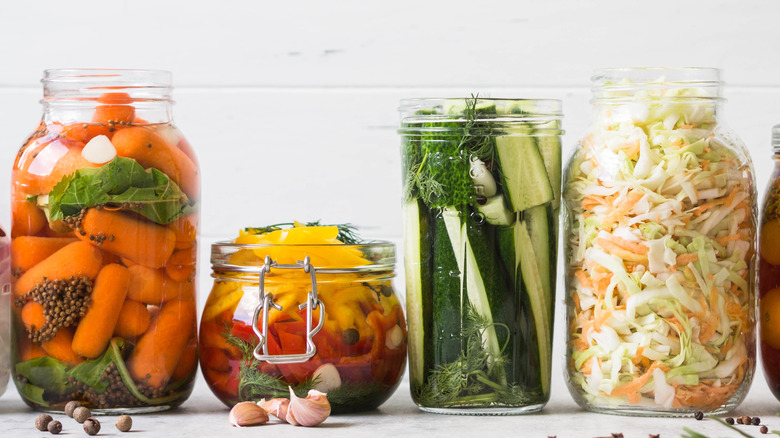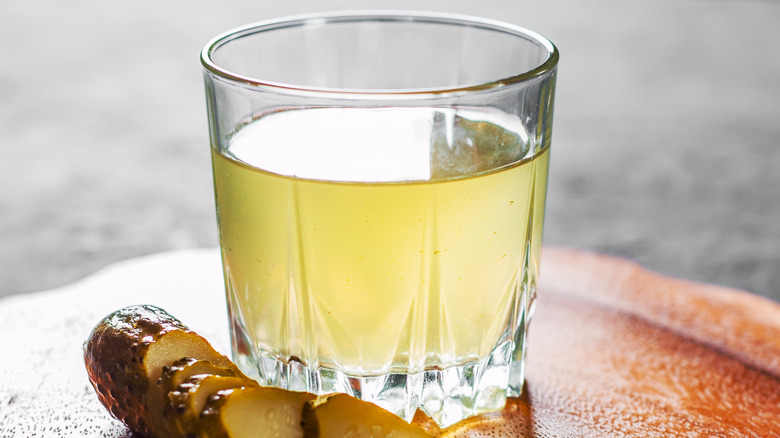14 Reasons Your Homemade Pickles Didn't Turn Out Right
There is so much more to pickles than that store-bought jar that's been lurking in the back of your fridge for years. And there's certainly more to them than those round slices stuck to the bottom of your fast food cheeseburger. So what exactly is a pickle? Simply put, it's a fruit, vegetable, egg, or meat preserved in an acidic brine. Pickling usually makes food sourer and softer; some pickles are fermented, and others aren't.
With home gardening and other similar hobbies on the rise (via The Guardian), you may be interested in getting into home pickling. And why wouldn't you be? There are so many different types of unique pickles, meaning the homemade pickle possibilities are basically endless. While the process is straightforward, it's not without its pitfalls. If you do it wrong, you could be left with some seriously nasty eats. In the worst-case scenario, your pickles could be dangerous to consume. But don't despair if your pickles don't turn out correctly the first time you make them.
This article will tell you all you need to know about why your pickles didn't turn out and when you can still eat them, even if they don't seem exactly right. Most importantly, you'll learn how to prevent these mistakes from happening again. That way, you won't find yourself in a pickle over your pickles next time.
Not knowing which type of pickle you're making
There are two main pickling processes: quick pickling and water bath pickling. It's imperative you know which kind of pickle your recipe is, or you may very well end up with a disaster on your hands. Almanac states that quick pickles aren't heated during processing and only keep in the fridge for a couple of weeks to a month. In contrast, water bath pickles can last about a year before opening.
For water-bath pickles, you need to heat your sealed jars in a water bath after you make your pickles. Only then can you preserve them at room temperature. Per The Science of Cooking, water bath pickling encourages the growth of lactic acid. This beneficial microorganism helps preserve our food. Unfortunately, if other microorganisms grow, you might be left with inedible pickles.
On the other hand, if you'd like to eat your pickles right away, try a homemade refrigerator pickles recipe. Be aware that these pickles will not last as long, but the process is much simpler.
Using spices incorrectly
There are so many different types of pickles you can make, and one of the ways to make pickles special is by customizing your spice blends. But you need to be careful with spices, because using them incorrectly can result in your pickles not turning out well. According to the National Center for Home Food Preservation, adding spices or herbs that aren't fresh can lead to soft and slippery pickles due to mold. Or, if you let your spices cook too long in vinegar, you could end up with bitter and pungent pickles. The same goes for if you use more spices than you should. With that in mind, follow your recipe for exact measurements and cooking times to ensure you have perfect pickles every time. If you used too many spices and your pickles are very dark in color, they are still safe to eat (via Oregon State University)
Incorrect vinegar concentration
You may be tempted to use flavored vinegar to liven up your pickles, but that's not a good idea. The University of Minnesota Extension says it's impossible to know the acidity level in homemade vinegars. Remember that pickling is mostly a science. You must use 5% acidity commercially-made vinegar.
When making fermented pickles, either white or apple cider vinegar is fine. Apple cider vinegar is a good choice because it has a mild and fruity flavor that pairs well with many vegetables, fruits, and spices. The University warns that it could darken your pickles, so be aware if you use it in place of white vinegar in a recipe. In contrast, distilled white vinegar does not change the vegetables' color.
You should never change or dilute the vinegar proportions a recipe calls for; vinegar helps keep pickles from growing botulism or other foodborne illnesses. If your vinegar is too weak, you can end up with spoiled or soft, slippery pickles. The pickles could be too strong and bitter if the vinegar is too strong. If your pickles are spoiled, toss them.
Pickling in dry weather
While cucumbers are a summer fruit, you should wait for a cooler summer if you want to pickle them. Cucumbers don't like drought; they need lots of water to thrive, since the fruit itself is about 95% water (per the USDA). Excessive summer heat can lead to cucumbers that are hollow in the middle. That makes for some rather disappointing pickles. Additionally, Hobby Farms says that cucumbers can be quite bitter if it has been a scorching hot summer. The outlet suggests you pickle other vegetables instead.
Some vegetables that thrive in heat and drought are okra, pole beans, and certain types of root vegetables (via The University of Florida). There are so many different pickled vegetables from around the world, so you shouldn't have trouble finding some fruits or vegetables that are in season, either in your garden or at the local market.
Using the wrong kind of salt
You should use canning or pickling salt to make your pickles. You should avoid using table salt in your pickles because manufacturers add iodine and anti-caking agents to table salt. If you do use table salt, your pickles will still taste fine and be safe to eat, but their appearance might be off-putting. The brine will likely turn cloudy, and the pickles themselves will be discolored, thanks to the added iodine and anti-caking agents. Due to its high mineral content, Himalayan pink salt isn't good for pickles either.
So, what salt should you use? Canning or pickling salts are perfect for pickling because they are 100% sodium chloride. If you can find additive-free kosher salt, you can use it as well. Remember that if you swap out salts in your recipe, you can't just use the same amounts. You must consider grain size and convert measurements accordingly (via Morton Salt).
Exposing pickles to sun
Pickles don't like sunlight. That makes the trend of "sun" or "solar pickles" confusing. Michigan State University Extension says that most recipes for sun pickles state to place a jar full of cucumbers, spices, salt, and liquid out in the sun to ferment. Unfortunately, three days outside in the sun means these pickles carry the risk of foodborne illnesses, such as E. coli or botulism.
That's because pickles can't ferment at temperatures above 72 degrees Fahrenheit. Hot summer sun plus a glass jar? That equals way more than 72 degrees. Also, many of the recipes out there aren't science-based. Michigan State recommends using science-based recipes to ensure that salt and liquid ratios correctly support fermentation.
According to the Mayo Clinic, E. coli symptoms — which include mild to severe gastrointestinal issues — usually start within a few days of eating the contaminated food but can begin as quickly as the same day. Foodborne botulism symptoms typically start within one to three days of consuming contaminated food. The symptoms include muscle weakness, blurry vision, and gastrointestinal issues (via the Centers for Disease Control and Prevention). You should contact your doctor immediately if you suspect you have symptoms of either.
Brining with wrong materials
Pickling is somewhere between science and art. As such, you need to think about the equipment you use just as much as you do your ingredients. First, iron, tin, and aluminum in your cooking utensils or water could make any garlic in your pickles green-blueish (per Clemson Cooperative Extension). That's fine. In fact, laba garlic — also known as jade garlic for its green color — is its own delicious variation of garlic. Traditionally served during the Chinese Laba Festival, this tasty pickled garlic is made with garlic, vinegar, and sugar.
However, certain scenarios exist where you do not want to eat your discolored pickles. Do not use brass, copper, or zinc pots or containers for brining. Do not eat your pickles if you have done so, especially if your pickles turn dark and discolored. What about other materials? You can make pickles in stoneware, glass, or food-grade plastic. Or, you can line your container with food-grade plastic bags. Note that if you use pickling lime, you should not use aluminum to make your pickles because the lime could cause the aluminum to leach into your pickles.
As a side note, you should also aim to use soft water instead of hard water to avoid excess minerals in your water.
Not processing pickles
If you intend to keep your pickles for long-term storage, you must process them. This method can be called "water bath canning," "hot water canning," or "boiling water bath." Almanac says water bath canning is for foods high in acid — like pickles. The outlet warns you should not use water bath canning for pickled meats or low-acid fruits and veggies, such as beans or corn. There is another process, called pressure canning, that you can use for these products.
Water bath canning is not difficult but requires specialized equipment, time, and sterilization. Note that you should always follow a recipe step-by-step and ensure it is from a trusted source. The process itself is like an assembly line. Make sure you have all your materials and ingredients prepped and ready to go before beginning to pickle. Otherwise, you'll be scrambling while canning, increasing the risk of errors and contamination.
If you don't follow a water canning process precisely, you must keep your pickles in the fridge and consume them within two weeks. If this seems too much, you can always quick-pickle your vegetables.
Improper sanitization
If your pickling ingredients aren't clean, you could be welcoming bacteria to grow in your pickling container. Iowa State University Extension says that soil is a common place where these bacteria lie. Bacteria can lead to a soft, limp pickle.
Your equipment needs to be squeaky clean. To make water bath pickles, you should use canning jars with two-piece lids. First, wash them with soap and water. If you're not going to heat the contents of your pickle jar for more than 10 minutes, you must also sterilize your jar before proceeding.
If you are making quick pickles, you don't have to sterilize your jars, but they do need to be clean to avoid spoilage. While the acid in pickle brine does help stave off harmful bacteria, it's not a panacea. Bacteria are fighters and will make their way into your food if you haven't done your prep work.
Waiting too long to pickle
The time between deciding to make pickles and the actual pickling needs to be quick. With cucumbers, for example, if you store them for even a full day in the fridge, they can lose enough crispness to lead to soft pickles in the preservation process. If your vegetables look a little limp, you can try to firm them up. Give them an ice water bath a few hours before you brine them (via The University of Minnesota Extension).
If you're using vegetables from your own garden, the time of day you harvest them matters for a couple of reasons. First, waiting too long between harvesting and pickling can lead to hollow pickles. You should also harvest your pickling veggies at the correct time of day, i.e., the cooler parts of the day. They will be limp from the hot summer sun if you harvest them in the heat.
Using the wrong produce
Selecting the right produce for pickling is key. For example, the Iowa State University Extension says if you're making pickled cucumbers, you need to use thin-skinned, smaller cukes to get perfect pickles. Don't use burpless cucumbers because their skins are too tough for the brine to penetrate. Likewise, if you buy cucumbers from the store, ensure they're not coated in wax. The wax is a sealant that prevents the brine from seeping into the cucumber. Oregon State University Extension recommends only using vegetables explicitly grown for pickling purposes. If your vegetables are "oddly shaped," consider using them for relishes.
The number one thing is that everything you use needs to be at peak freshness and quality. While pickling is a method of food preservation, it's not a method of food resuscitation. As long as you have ensured your produce is fresh, the sky's the limit. And there are so many different types of pickled vegetables you should have in your fridge. You may be familiar with pickled red onions and kimchi, but what about pickled cauliflower or mushrooms? These unique pickles make wonderful snacks, condiments, and hors d'oeuvres.
Not prepping your ingredients correctly
You might end up with undesirable pickles if you don't prep your produce correctly. Here's one tip crunchy pickle fans need to know: Slice your vegetables thick before brining them. The University of Minnesota Extension says thick chunks or slices will ensure a crispier result than if you pickle a whole cucumber or other vegetables. That's not to say you can't pickle whole vegetables, but it is worth noting. You also don't want to slice your produce too thinly because it will become too soft in the pickling process.
Also important is to remove about ¹⁄₁₆ inch off the blossom end of the cucumber. That part of the fruit contains an enzyme that will release and soften your whole batch during the fermentation process if you don't remove it. Or, you can add a grape or tea leaf with your pickles. The tannins in these leaves counteract that enzyme.
Not following the exact recipe
Think of pickling more like baking than cooking: it is a science, and when you stray from the recipe, you may end up with pickles that taste bad or, worse, that are unsafe to eat. Measuring all your fruits and vegetables correctly is essential, per Almanac. Further, North Dakota State University warns that you should only use recipes with ratios that have been tested. For example, if you are making fermented pickles, you cannot reduce the required salt content. However, you can play around with the salt content of refrigerator pickles. If a recipe calls for whole spices, use whole spices.
According to Oregon State University Extension, different vegetables require different methods and materials for pickling. Therefore, you can't just mix and match.
There are many types of favorite pickle recipes, from classic dill to the underrated apple pickle. Quick pickling is very popular these days. Because the pickles are stored in the fridge, and for a shorter time, spoilage from incorrect measurements isn't as big a concern.
Reusing pickle brine
According to Clemson Cooperative Extension, you should never reuse your pickling brine to make another batch of pickles. That doesn't mean you have to waste leftover brine, though. You can do many delicious things with your leftover brine, such as using it as a salad dressing or a marinade within a couple of days. If you see any traces of mold, it's time to toss it out.
Try a pickle juice vinaigrette recipe over salad or fish. Or how about a pickle juice-brined fried chicken recipe? There is also a plethora of pickle juice cocktail recipes out there. You can even drink pickle juice straight. Ohio State University says the juice from fermented pickles contains probiotics that are good for your gut. Also, due to its sodium and potassium content, a little bit of pickle juice can help restore electrolytes during a hangover or after a workout. Of course, it's also high in sodium, so keep that in mind.
